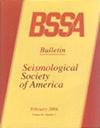基于地震动模拟和降阶模型的区域尺度土壤-结构相互作用效应:以2008年m5.4 Chino Hills主震为例
IF 2.9
3区 地球科学
Q2 GEOCHEMISTRY & GEOPHYSICS
引用次数: 1
摘要
本文以2008年南加州奇诺山5.4级地震为例,展示了土壤-结构相互作用(SSI)在区域尺度上对三种理想建筑类型的影响。这三座建筑都位于浅地基上,它们都受到三分量模拟地面运动的影响。为了完成这项任务,我们为每个建筑类型开发了一个降阶模型(ROM),该模型在时域上解释了SSI对建筑系统的影响。利用集合卡尔曼反演(EnKI)从全耦合土壤-地基-结构相互作用模拟中提取土壤阻抗值;并对EnKI结果进行插值,推导出跨越土壤阻抗模型适用范围的解析函数。然后,我们通过将结果与完全耦合的土壤-基础-结构相互作用模拟(也称为直接建模方法)进行比较来验证我们的rom。最后,我们用经过验证的建筑rom填充了整个南加州的模拟网格,并以地图的形式解释了响应,这些地图代表了SSI对地震需求参数(如最大位移、加速度和层间漂移)的城市尺度影响。考虑到特定建筑的共振特性、基础类型和当地场地条件,我们还确定了SSI影响的区域,这些区域相对于固定基础的响应会导致更高的地震需求。本文章由计算机程序翻译,如有差异,请以英文原文为准。
Soil–Structure Interaction Effects on a Regional Scale through Ground-Motion Simulations and Reduced Order Models: A Case Study from the 2008 Mw 5.4 Chino Hills Mainshock
We demonstrate the effects of soil–structure interaction (SSI) for three idealized building typologies on a regional scale, using a simulated earthquake scenario of the 2008 Mw 5.4 Chino Hills mainshock in southern California as an example. All the three buildings lie on shallow foundations, and they are subject to three-component simulated ground motions. To carry out this task, we develop a reduced order model (ROM) for each building typology that accounts for the effects of SSI on the building system in the time domain. We specifically use ensemble Kalman inversion (EnKI) to extract the soil impedance values from fully coupled soil–foundation–structure interaction simulations; and we interpolate the EnKI results to derive analytical functions that span the range of applicability of the soil impedance model. We then verify our ROMs by comparing results to fully coupled soil–foundation–structure interaction simulations, also known as direct modeling methods. We finally populate the simulation grid across southern California with the verified building ROMs, and interpret the responses in the form of maps that represent urban-scale effects of SSI on the seismic demand parameters such as maximum displacement, acceleration, and interstory drift. We also identify areas where the effects of SSI, given the resonant characteristics of a specific building, the foundation typology, and the local site conditions, lead to higher seismic demand relative to the fixed-base response.
求助全文
通过发布文献求助,成功后即可免费获取论文全文。
去求助
来源期刊

Bulletin of the Seismological Society of America
地学-地球化学与地球物理
CiteScore
5.80
自引率
13.30%
发文量
140
审稿时长
3 months
期刊介绍:
The Bulletin of the Seismological Society of America, commonly referred to as BSSA, (ISSN 0037-1106) is the premier journal of advanced research in earthquake seismology and related disciplines. It first appeared in 1911 and became a bimonthly in 1963. Each issue is composed of scientific papers on the various aspects of seismology, including investigation of specific earthquakes, theoretical and observational studies of seismic waves, inverse methods for determining the structure of the Earth or the dynamics of the earthquake source, seismometry, earthquake hazard and risk estimation, seismotectonics, and earthquake engineering. Special issues focus on important earthquakes or rapidly changing topics in seismology. BSSA is published by the Seismological Society of America.
 求助内容:
求助内容: 应助结果提醒方式:
应助结果提醒方式:


